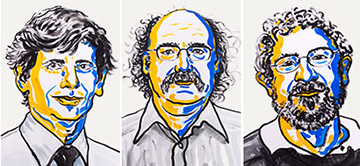
Left to right: 2016 Nobel Physics laureates David J. Thouless, F. Duncan M. Haldane and J. Michael Kosterlitz. [Illustrations by N. Elmhed, © Nobel Media 2016]
The 2016 Nobel Prize in Physics has gone to three scientists who opened new theoretical perspectives in thinking about basic states of matter. The prize was divided between David J. Thouless, who received half of the award, and F. Duncan M. Haldane and J. Michael Kosterlitz, who split the other half, for “theoretical discoveries of topological phase transitions and topological phases of matter.”
The work of these scientists, undertaken in the 1970s and 1980s, has in the past decade come to breathtaking fruition in new, exotic physics—some in the realm of optics—ranging from topological insulators to the foundations for quantum computing.
Topological systems
The three scientists were honored for their theoretical application of the mathematics of topology to physical systems such as superconductors, ferromagnetism, and superfluid helium, and in particular to phase transitions within such materials.
Topology deals with properties of systems that hinge on their geometry—and, in particular, with properties that are preserved under continuous deformation, such as stretching, and can only be altered by breaking. The classic example of a topological system is a torus or donut, which retains its “hole in the center” geometry until we bite off a piece. Another example, more germane to the current work, is a tornado or vortex.
As these examples suggest, changes in a system’s topology operate stepwise rather than continuously, and in integer steps—a donut has one hole, a pretzel has two or three. (Or, as Nobel Committee member Thor Hans Hansson quipped at the prize announcement, “you can't have half a tornado.”)
The three 2016 physics laureates all made significant theoretical contributions in applying such topological thinking to real physical systems, at a fundamental level. Among the key outcomes were the so-called Kosterlitz-Thouless (KT) phase transition, developed in the 1970s, which explained phase transitions in low-temperature superfluids and superconductors in topological terms, based on the quantized behavior of vortex pairs in matter. Later, in the mid to late 1980s, Thouless and Haldane applied topological mathematics to explain the mystery of the quantum Hall effect—the quantization of electrical conductance in integer steps that had been observed in previous Nobel Prize–winning work by Klaus von Klitzing in 1980.
Fruitful ideas
Arcane as the work might seem, it has proved enormously influential in condensed-matter physics, and is making inroads into photonics as well. One particularly interesting long-term outcome, predicted by Haldane in the 1980s, has been the discovery of so-called topological insulators, which are materials that are insulating in bulk but conducting along the edges, with the properties dependent on the topological state.
Such work in solid-state materials has in the past several years found analogs in photonics, such as work at the Joint Quantum Institute of the University of Maryland and elsewhere demonstrating systems that can transmit light on the edges but have a photonic band gap in bulk. The recent ferment in photonic topological order was highlighted by a 2014 Incubator meeting at The Optical Society in which researchers discussed the prospects for such topological photonic systems in areas such as quantum computing and quantum simulation.
Key role for optical lattices
On a more fundamental level, the recent advances building on the laureates’ theoretical work from three decades ago have, in a very real sense, been enabled in part by optical and photonic technology—in particular by the ability to laser-cool and trap low-temperature atoms in optical lattices, responsible in itself for a number of previous Nobel physics prizes. This has allowed researchers to use ensembles of cold atoms as a testbed for the ideas previously approachable only theoretically by Thouless, Kosterlitz and Haldane. In his 1988 paper on the quantum Hall effect, for example, Haldane himself wrote that his model was “unlikely to be directly physically realizable”; in 2014, a team led by Tilman Esslinger at ETH Zurich, Switzerland, did just that, using ultracold potassium atoms trapped in an optical lattice.
In remarks to the press after the prize announcement, Haldane mused on the unexpected directions that his research, and that of the other two laureates, have taken across more than three decades. “You never set out to discover something,” he said. “You just kind of stumble onto it, and have the luck to realize that it’s something very interesting.”
